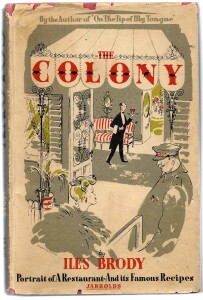No 3: The Colony, New York City
In the days before Michelin starred restaurants there were places where the well heeled went to eat —not only for the food, which was obviously excellent, but perhaps not always the most innovative—and of these the Colony, at the intersection of Madison Avenue and Sixty-First Street in Manhattan, became by 1948, when a biography of it was published by Iles Brody– arguably the best known in the world. Indeed, the owners of the Colony called their eating place ‘the greatest restaurant in the world.’
The Colony began in 1920 as a small and rather seedy and ‘disreputable ‘ bistro that served good food to customers of the night club above it, many of who were men who brought their mistresses. Then in 1922 its two chefs, Glen Cavallero and Hartmann, plus Head Waiter, Cerutti, brought out the owner, one Joe Pani, for $25,000 and set about making the new Colony a swanky resort of the rich and famous. Despite the quality of the food, takings were poor for the first few months. The Colony could not shake off its reputation as a ‘ cat house ‘. However, before too long, without any help from Gordon Ramsay, things began to look up thanks to the presence at one of the tables of famous society hostess Mrs Vanderbilt. The multi-millionaire Vanderbilt, encouraged by his wife, came to see what the fuss was about and later brought his sixteen-year old daughter. Word got about and before too long the Colony became a regular haunt of New York Society. Within three months the daily takings grew from one hundred dollars to ten times that amount. By 1927 – 8 the restaurant cleared over half a million dollars yearly. By this time the Colony had moved to the more ‘ aristocratic ‘ Sixty-first Street, just around the corner.
There were problems though for a high-class restaurant that sold ‘ liquor’ at a time of Prohibition, but the chief barman had a cunning ruse. He kept his wines and spirits in an elevator and when he was alerted to the imminent arrival of Federal agents he simply ran the elevator car to the top story. And when agents disguised as customers enquired pf the liquor that was being served at table they were informed that it was brandy, but of superior quality to the stuff that was habitually confiscated. A few tots freely donated to the same agents convinced them to keep their mouths shut regarding this blatant violation of Federal law.
During the twenties the Colony became ‘the world’s unique social centre ‘–the haunt of such luminaries as ‘the King of Greece, Charlie Chaplin, two three Astors, some Vanderbilts, Gloria Swanson, Bernard Baruch, the Prince of Wales, the Churchills, the Crown Prince of Sweden, Mrs Franklin D. Roosevelt, Lords Northcliffe and Rothermere, Louis B. Mayer, the King of Siam, Walter Winchell, Helen Hayes, Lord Beaverbrook, Alexander Korda and the Duc D’ Orleans.’ If Brody is to be believed, the quality of the cuisine at the restaurant and the willingness of its chefs to cook anything required at any time by such demanding clients, is the main reason why the place retained its high reputation among gourmets. A list of the six best restaurants compiled in 1931 placed The Colony top, with the Ritz-Carlton, The Paris Ritz, the Foyot and the Tour d’Argent following in order.
Brody’s Colony is replete with anecdotes of the rich and famous—the day bidets were installed in the hotel to the disgust of all the female habituees, who refused to use this French ‘ contraption ‘ in their powder room—the spoilt pooches of these same ladies that were fed on chocolate ice cream and chicken breast—the absinthe added to the horrible Prohibition gin to give it some flavour—the frequent poker games lasting from Saturday to Sunday night in which men like George Gershwin, Irving Berlin, Samuel Goldwyn and other denizens, played for the thrill rather than for money—the prodigious feats of drinking and eating, involving in one case the gourmand Bradford English, who would always dine alone and might guzzle two pounds of caviar as an appetizer follow this with two pheasants and a venison steak and wash all this down with champagne.
However, when we look back at the favourite dishes served up at the Colony, the tastes catered for seem rather unadventurous compared with what has been seen as exciting and glamorous in the top restaurants of Europe and the UK over the past five or more decades. Perhaps gourmets here and in the Continent have become so used to modern haute cuisine that we have forgotten how ‘ homely ‘ so much of the food served up to wealthy dinners was back in the twenties and thirties. Here is a selection of some of the Colony specialties:
Hors D’Oeuvre.
Anchovy butter, canapés of Sardines, white bean salad, turnip salad, salad of celery leaves, left-over meat salad, Swiss canapé, corn salad, canned salmon canapés.
Soup.
Onion soup, Gumbo or okra Soup, mulligatawny Soup, puree of white beans Colony, puree of dried kidney beans, puree of split peas, cream of celery Colony, cream of spinach Colony, cream of chicken colony. All very delicious, no doubt, but what can be said of such oddities as tomato soup with tapioca or Waterbury soup Colony. with its ingredient of curry powder.
Egg dishes.
Omelette, poached eggs tourangelle, eggs beurre noir.
Meat dishes
Brains piquante ( how many Michelin starred chefs would dare served these today ?), steak and kidney pudding, coq au vin, Hungarian beef goulash, roast beef with Yorkshire pudding ,
Pigeon pie.
Desserts
Crepes suzette, vanilla soufflé, ananas au kirsch, bread and butter pudding.
Having said all that, there are plenty of dining rooms in the City and in London Clubland today which regularly feature many of these well established old favourites. [R.M.Healey ]

